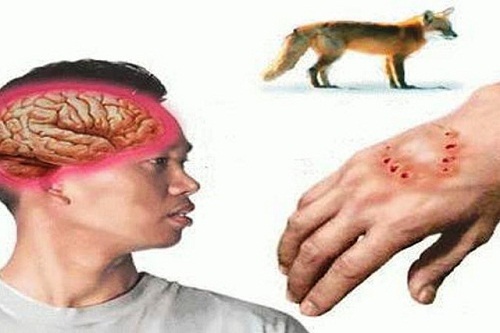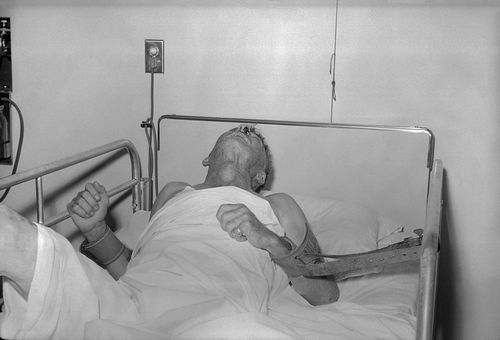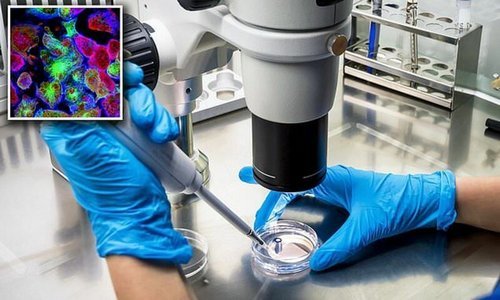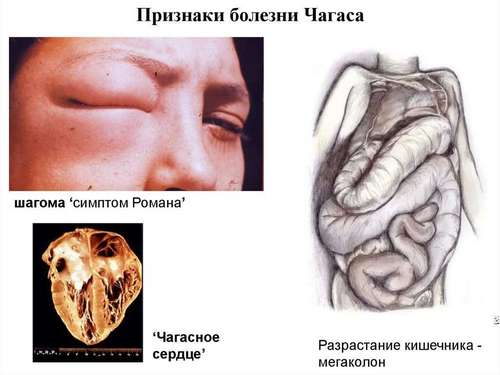Rabies is an infectious zoonotic diseases of viral etiology, characterized mainly by severe lesions of the Central nervous system, threatening death. A person infected with rabies by the bite of animals. Spreading along the nerve fibers, rabies virus initially increases their excitability, and then calls the development of paralysis.
Penetrating into the tissue of the spinal cord and brain virus causes serious violations of the functioning of the CNS, clinically manifested phobias, bouts of aggressive excitement, delusional syndrome.
Rabies is still an incurable disease. For this reason, it is difficult to overestimate the importance of preventive rabies vaccination, the patient in case of animal bite.
Rabies
Rabies is an infectious zoonotic diseases of viral etiology, characterized mainly by severe lesions of the Central nervous system, threatening death. A person infected with rabies by the bite of animals.
Characterization of the pathogen
Rabies causes RNA-containing rhabdovirus having a bullet shape and with two specific antigens: soluble and surface AgS AgV&. During the replication process of the virus contributes to the neuron-specific inclusions – eosinophilic Taurus Babes-Negri. The rabies virus is quite resistant to cooling and freezing, but are easily inactivated by boiling, ultraviolet radiation, and disinfection of the different chemicals (Lysol, bleach, carboxylic acid, corrosive sublimate, etc.).

Reservoir and source of rabies are the carnivorous animals (dogs, wolves, cats, some rodents, horses and cattle). Animals excrete virus with saliva, contagious period begins 8-10 days before development of clinical signs. Sick people are not a significant source of infection. Rabies is transmitted parenterally, usually during bite man sick animals (saliva, containing the pathogen gets into the wound and the virus gets into the bloodstream). Currently, there is evidence about the feasibility of aerogenic, nutritional, and transplatzentarnogo path of infection.
People have limited natural susceptibility to rabies, the risk of infection in case of infection depends on the location of the bite and the depth of damage and ranges from 23% of cases with bites of the limbs (proximal) to 90% in the case of a bite to the face and neck. In a third of cases infection occurs through the bite of a wild animal, and, in other cases, the perpetrators of the destruction of human rabies are domestic animals and livestock. In the case of timely access to medical care and preventive measures in the full measure of rabies in infected individuals does not develop.
The pathogenesis of rabies
The rabies virus enters the body through broken skin and spreads through the fibers of the nerve cells, which has a pronounced affinity. In addition, the possible spread of the virus throughout the body through the blood and lymph. A major role in the pathogenesis of the disease is played by the ability of the virus to bind to acetylcholine receptors of nerve cells, and increase reflex excitability, and then to cause paralysis. The penetration of the virus into the cells of the brain and spinal cord lead to serious organic and functional disorders of the Central nervous system. Patients develop hemorrhage and brain edema, necrosis and degeneration of its tissue.
In the pathological process involved the cells of the cortex of the hemispheres, the cerebellum, the optic thalamus and podbugorie region, and nuclei of cranial nerves. Inside brain neurons by microscopy are marked eosinophilic education (Taurus the Babes-Negri). Pathological degeneration of cells leads to functional disorders of organs and systems due to violations of the innervation. Of the Central nervous system the virus spreads to other organs and tissues (lungs, kidneys, liver, and endocrine glands, etc.). Hit him in the salivary glands leads to the release of the pathogen with saliva.
The symptoms of rabies
The incubation period of rabies can vary from a couple of weeks in the localization of the bite on the face or neck to a few months (1-3) with the introduction of the pathogen in the region of the limbs. In rare cases, the incubation period was delayed up to a year.
Rabies occurs with a succession of three periods. In the initial stage (depression), there is a gradual change in the behavior of the patient. In rare cases depression is preceded by General malaise, low-grade fever, pain in the gate area of infection (usually Saiva to the beginning of the disease wounds). Sometimes (rarely) the place of introduction of the pathogen re-inflamed. Usually in this period, the clinic is limited to the manifestation from the Central nervous system (headaches, sleep disorders, loss of appetite) and psychological (apathy, depression, irritability, depression and anxiety). Sometimes patients may feel chest discomfort (tightness), suffer digestive problems (normally constipation).

The height of the disease (stage of excitement) occurs 2-3 days after the first signs of depression, characterized by the development of various phobias: fear of water, air, sounds and light. Hydrophobia – fear of water – prevents the patients to drink. Typical behavior – when pulling the glass of water, I’ll happily takes it, but attempt to drink the liquid may cause bouts of paralyzing fear, suspension of breathing and the patient throws the glass. However, not always accompanied by a rabies hydrophobia, which can complicate diagnosis. With the progression of the disease, patients suffer from severe thirst, but due to the formed a reflex even the sight and sound of water cause spasms of the respiratory muscles.
Aerophobia is characterized by attacks of breathlessness, in connection with the movement of air, when austialia and photophobia this reaction is observed in noise and bright light. The short-term asthma attacks (a few seconds), they are accompanied by spasms and convulsions of facial muscles, pupil dilation, patients are excited, experiencing panic, scream, throw my head back. There is trembling of the hands. The breath during the paroxysms of intermittent, wheezing, breaths noisy. Breathing involves the muscles of the shoulder girdle. In this period, patients are in the excited state aggressive, shout a lot, are prone to haphazard aggressive activity (rushing, can hit or bite). Characterized by hypersalivation.
As the disease progresses bouts of excitation are becoming more common. Marked weight loss, excessive sweating, there are hallucinations (auditory, visual, and olfactory). The duration of the period of excitation is 2-3 days, rarely lengthened to 6 days.
The terminal stage of the disease – paralytic. In that period, patients become lethargic, their movements are restricted, the sensitivity is reduced. Due to the decrease in phobic paroxysms occur the false impression that the patient got better, but at this time quickly body temperature rises, develops tachycardia and hypotension, occur paralysis of the limbs, and in the future and cranial nerves. The defeat of the respiratory and vasomotor center, causing cardiac arrest and respiratory arrest and death. Paralytic period may last from one to three days.
Diagnosis of rabies
There are methods of isolation of rabies virus from the cerebrospinal fluid and saliva, in addition, there is a possibility of diagnosis using the reaction of fluorescent antibodies in biopsies of the dermis, the fingerprints of the cornea. But in view of the complexity and economic inexpediency of these methods are not applicable in wide clinical practice.
Mostly the diagnosis is carried out based on clinical picture and epidemiological history. For diagnostic techniques, with lifetime nature, also include bioassay in laboratory animals (neonatal mice). When infected them isolated from saliva, cerebrospinal fluid or lacrimal fluid with the virus, the mice die after 6-7 days. Histological analysis of brain tissue of the deceased patient allows finally to confirm the diagnosis in case of detection in the cells of Taurus the Babes-Negri.
Treatment of rabies
Currently, rabies is an incurable disease, therapeutic interventions are palliative in nature and aimed at facilitating the patient’s condition. Patients are hospitalized in a darkened shumoizolyatory chamber, they prescribe symptomatic agents: hypnotics and anticonvulsants, painkillers, tranquilizers. Nutrition and rehydration measures are carried out parenterally.
There is active testing of new treatment regimens using specific immunoglobulins, immunomodulators, hypothermia of the brain and techniques of intensive therapy. However, until now, rabies is a fatal disease: lethal outcome occurs in 100% of cases development of clinical symptoms.
Prevention of rabies
Prevention of rabies in the first place aimed at reducing morbidity among animals and limit the likelihood of the bite of stray and wild animals human. Pets are subjected to mandatory routine vaccination against rabies, decreed categories of citizens (employees of veterinary services, subcolony, hunters, etc.) are immunized with rabies vaccine (a three-fold intramuscular introduction). A year later, the revaccination is made in the future in the preservation of the high risk of infection, recommended a repeat immunization every three years.
In case of animal bite to be made a package of measures aimed at preventing rabies: the wound is washed with rubbing alcohol, treated with antiseptics, aseptic bandage is applied, then you should immediately contact emergency station (either to the surgeon or paramedic FAP). Promptly is undergoing preventive rabies vaccination (inactivated dry vaccine) and passive immunization (rabies immunoglobulin). The scheme of prophylactic injections depends on the location of the bite, the depth of the wound and degree of contamination with saliva.




I’m not sure where you are getting your information, but great topic. I needs to spend some time learning much more or understanding more. Thanks for fantastic information I was looking for this info for my mission.